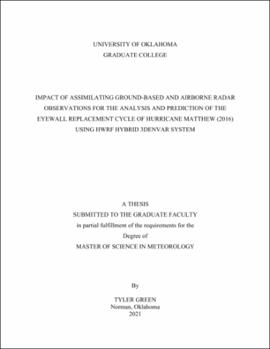| dc.contributor.advisor | Wang, Xuguang | |
| dc.contributor.author | Green, Tyler | |
| dc.date.accessioned | 2021-08-05T20:57:51Z | |
| dc.date.available | 2021-08-05T20:57:51Z | |
| dc.date.issued | 2021-08-05 | |
| dc.identifier.uri | https://hdl.handle.net/11244/330232 | |
| dc.description.abstract | Eyewall replacement cycles (ERC) are common dynamical processes in mature tropical cyclones (TCs) that can result in quick changes to the storm’s intensity and wind field size. As the resolution of TC models increases, accurate initializations of concentric eyewall (CE) structure through advanced data assimilation (DA) are hypothesized to be important to capture the ERC and the associated rapid intensity change by numerical models. In this study, the analysis and prediction of Hurricane Matthew’s (2016) ERC is examined using HWRF and a Hybrid 3D Ensemble-Variational DA scheme. Four experiments performing hourly DA cycling from 1500 UTC October 6 to 1500 UTC October 7 are performed, assimilating different sets of inner-core doppler radar radial velocity observations, including Tail-Doppler Radar (TDR), coastal Ground-Based Radar (GBR), and their combination. The primary scientific objective of this study is to assess the impacts of assimilating GBR and TDR radial velocity observations individually, and in combination, on the analysis and forecast of Matthew during the weakening and reintensification phase of its ERC.
Results show that the earlier availability and continuous coverage of GBR observations is needed to make quick corrections to initialize CE structure, even with limited lower-level coverage of the storm. The subsequent forecasts from the experiments assimilating GBR observations demonstrated the capability to make realistic and consistent forecasts of the structural and intensity changes associated with the ERC. The TDR experiment revealed that as a result of the later start and shorter duration of inner core doppler radar observation availability, the analyses’ structure throughout the cycling period was not as realistic compared to the expected structural changes of the ERC, as were the GBR and GBTDR experiments. This is hypothesized to be a result of the varying horizontal coverage of TDR observations within the DA time window from analysis time to analysis time during high frequency DA cycling. As a result of this, the TDR forecasts did not show the ability to consistently capture the correct structural and intensity changes during the ERC. With no assimilation of ICDR observations, the Control experiment demonstrated no ability to make correct analyses and forecasts of Matthew’s CE structure and ERC. The importance of correctly initialized structure was highlighted by showing that the evolution of the primary and secondary eyewall structure is consistent with balanced and unbalanced dynamics in an axisymmetric framework. Proper initialization of the secondary eyewall governs the evolution of the ERC by restricting high angular momentum air from reaching the primary eyewall, acting to contract and intensify the secondary eyewall and spin down the primary eyewall. | en_US |
| dc.language | en_US | en_US |
| dc.subject | Eyewall Replacement Cycle | en_US |
| dc.subject | HWRF | en_US |
| dc.subject | Data Assimilation | en_US |
| dc.subject | Doppler Radar | en_US |
| dc.title | Impact of Assimilating Ground-Based and Airborne Radar Observations for the Analysis and Prediction of the Eyewall Replacement Cycle of Hurricane Matthew (2016) Using HWRF Hybrid 3DEnVar System | en_US |
| dc.contributor.committeeMember | Schenkel, Benjamin | |
| dc.contributor.committeeMember | Biggerstaff, Michael | |
| dc.date.manuscript | 2021-08-05 | |
| dc.thesis.degree | Master of Science in Meteorology | en_US |
| ou.group | College of Atmospheric and Geographic Sciences::School of Meteorology | en_US |
| shareok.orcid | https://orcid.org/0000-0003-1642-218X | en_US |
